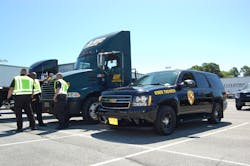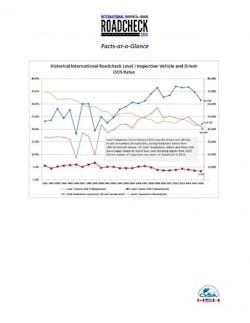CVSA releases 2016 Roadcheck results
A total of 62,796 inspections were conducted during this year’s International Roadcheck enforcement campaign, of which 42,236 were Level I inspections, the most comprehensive vehicle inspection level. Of Level I inspections, 21.percent of vehicles and 3.4 percent of drivers were placed out of service due to critical item violations.
Of vehicles placed out of service, brake adjustment and brake system violations combined to represent 45.7 percent of out-of-service vehicle violations. The top driver out-of-service violations were for hours of service and false logs, representing 46.8 percent and 16.4 percent, respectively, of all out-of-service driver violations found.
Commercial motor vehicle inspectors throughout North America conducted driver and vehicle safety inspections on large trucks and buses during the Commercial Vehicle Safety Alliance’s (CVSA) 29th annual International Roadcheck in June.
International Roadcheck is a three-day event when CVSA-certified inspectors conduct compliance, enforcement and educational initiatives targeted at various elements of motor carrier, vehicle and driver safety. International Roadcheck is the largest targeted enforcement program on commercial motor vehicles in the world, with around 15 trucks or buses inspected, on average, every minute across North America during a 72-hour period.
Each year, International Roadcheck places special emphasis on a category of violations. The focus for 2016 International Roadcheck was tire safety. This year, tire/wheel violations accounted for 18.5 percent of the total percentage of out-of-service violations. In the U.S., tire violations represented 13.7 percent of out-of-service vehicle violations. Checking a vehicle’s tires is always part of roadside inspections; however, this year, CVSA chose to highlight tire safety as a reminder to drivers and carriers of the importance of proper tire use and maintenance. As part of the inspection process, inspectors measured tire tread depth, checked the tire pressure, checked to ensure no solid objects were lodged between dual tires and examined the overall condition of the tire to make sure no deep cuts or bulges were found on tire sidewalls.
“CVSA’s annual 72-hour International Roadcheck initiative highlights the commitment of our inspectors who work hard every day to ensure unsafe vehicles and drivers are removed from our roadways,” said CVSA Executive Director Collin Mooney. “It’s also an opportunity for our inspectors to inspect, acknowledge and document the safe, fit and compliant commercial motor vehicles traveling our roadways by placing a CVSA decal on the vehicle; indicating that a particular vehicle has passed CVSA’s rigorous inspection standards.”
Most inspections conducted during International Roadcheck are Level I inspections. A Level I inspection is a 37-step procedure that involves an examination of both the driver’s record of duty status and the safety of the vehicle. Drivers are required to provide items such as their license, endorsements, medical card and hours-of-service documentation, and are checked for seat belt usage and the possible use of alcohol and/or drugs. The vehicle inspection includes checking items such as the brake systems, cargo securement, coupling devices, exhaust systems, frames, fuel systems, lighting devices, steering mechanisms, suspensions, tires, van and open-top trailer bodies, wheel assemblies, windshield wipers, and emergency exits, electrical cables and systems in engine and battery compartments, and loose or temporary seating on buses. Other inspections conducted included Level II walk-around, Level III driver-only, and Level V vehicle-only inspections.
“International Roadcheck is an annual reminder of the diligence and dedication of law enforcement officials and commercial motor vehicle safety professionals,” said FMCSA Administrator T.F. Scott Darling, III. “While their tireless efforts every day greatly increase the level of safety on our roadways, it is critically important that everyone do their part to promote a national culture of roadway safety."

